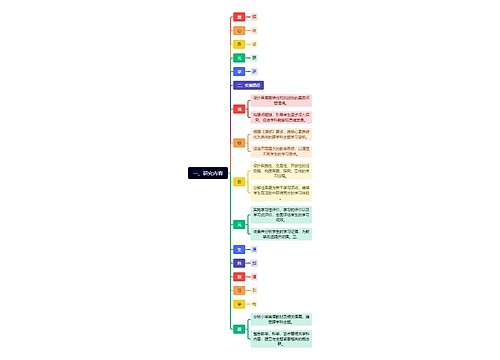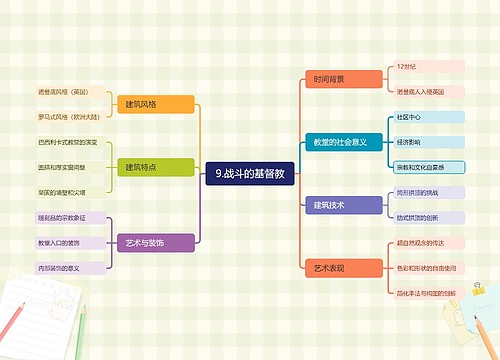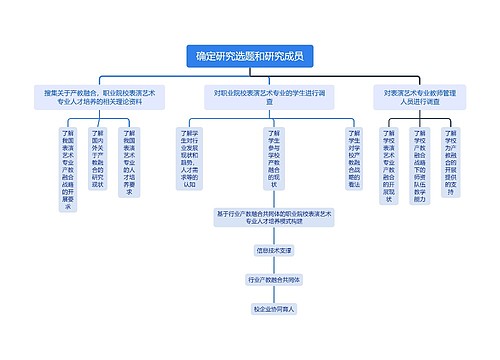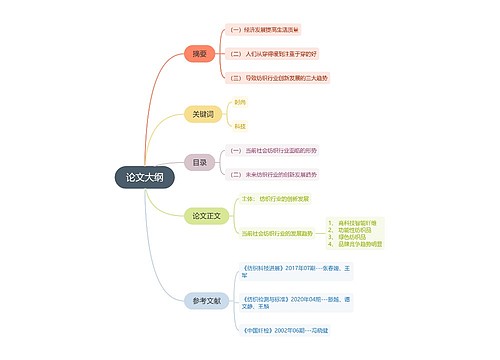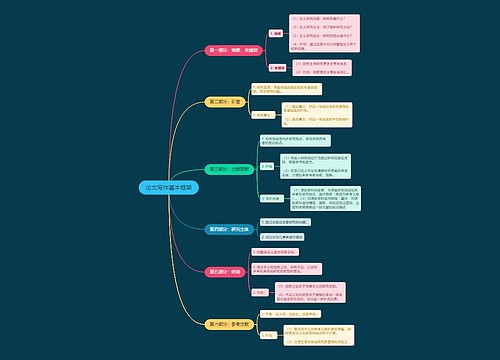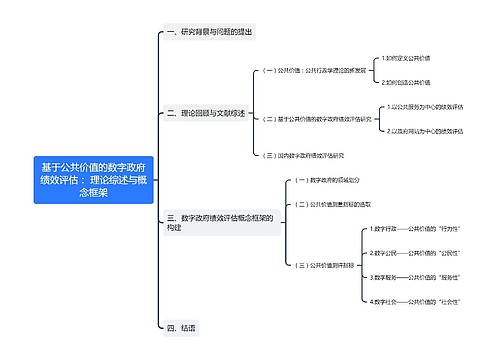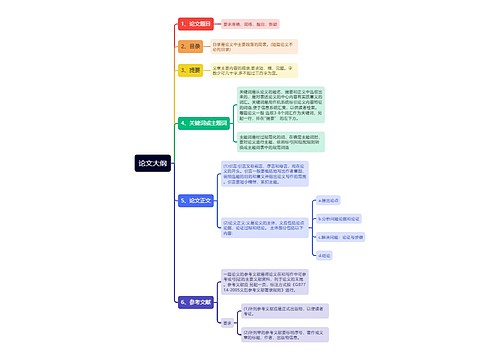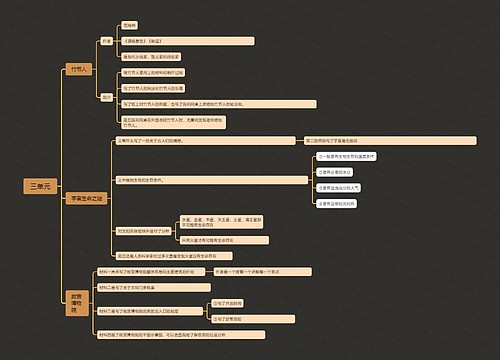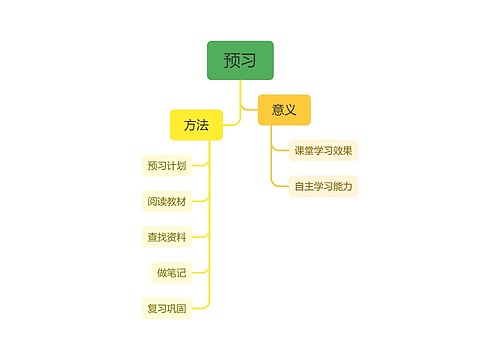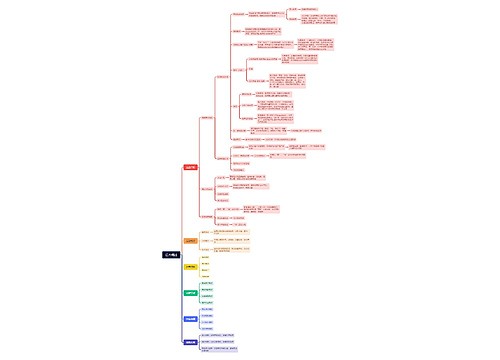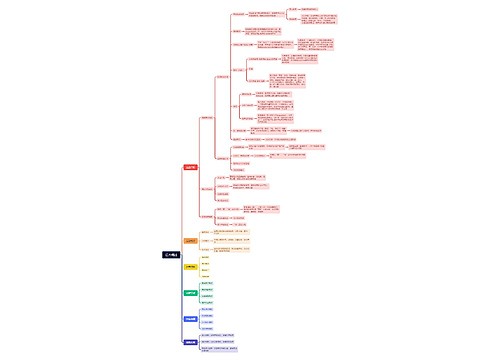
读后续写在高中英语写作教学的有效性研究思维导图
U348866814
2023-10-28

定义
理论基础
文献述评
读后续写在高中英语写作教学的有效性研究介绍
树图思维导图提供《读后续写在高中英语写作教学的有效性研究》在线思维导图免费制作,点击“编辑”按钮,可对《读后续写在高中英语写作教学的有效性研究》进行在线思维导图编辑,本思维导图属于思维导图模板主题,文件编号是:ee5caeec05941e171ea6baa4a485d550
思维导图大纲
相关思维导图模版
读后续写在高中英语写作教学的有效性研究思维导图模板大纲
研究背景
研究目的和意义
研究意义
文献综述
定义
理论基础
输入假说理论
输出假设理论
协同效应理论
文献述评
参考文献:
[1] Carson, J. G. & Leki,I. Reading in the Composition Classroom: Second Language
Perspectives[M]. Boston: Heinle & Heinle. 1993.
[2] Gass, S.M. 1997. Input, Interaction, and Second Language Learner[M]. Mahwah,
NJ: Lawence Erlbaum Associates.
[3] Garrod, S. & Pickering, A. M. J. Why is conversation so easy? [J].
Sciences
[4] Krashen, S. D. Principles and practice in second language acquisition. Oxford: Pergamon Press,
1982.
[5] Laufer,B & Nation. P. A vocabulary-size test of controlled productive ability
Language testing. 1995, 16 : 33-51.
[6] Nunan, D. Practical English Language Teaching. Beijing: Tsinghua University Press, 1999
[7] Stotsky, S. Research on reading/writing relationships: a synthesis and suggested directions [J].
Language Arts, 1983,60(5): 627-642.
[8]Swain, M. Communication competence: Some roles of comprehensible input and comprehensible output in its development. In S. Gass & C. Madden (Eds.), Input in second language acquisition. Rowley, MA: Newbury House.1985,15(1): 167-179.
[9] Swain, M.& Lapkin, S. 1995. Problems in output and the cognitive processes they generate: A step towards second language learning [J]. Applied Linguistics 16:371-391.
[10]Tompkins. G. E. Literacy for the 21st Century [M] New Jersey: Pearson Education, 2003.
[11] Widdowson, H. G. Talking shop: H. G. The roles of teacher and learner [J].
Language Teachers Journal,
9
[12] Waiking, Tsang. Comparing the Effects of Reading and Writing on Writing
Performance[J]. Applied Linguistics. 1990, 17(2): 210-233.
[13] 陈立平.从阅读与写作的关系看写作教学中的范文教学[J].外语与外语教学,2001(04):28-29+38
[14] 姜琳,陈锦.读后续写对英语写作语言准确性、复杂性和流利性发展的影响 [J].现代外语,2015,38(3):366-375.
[15]姜琳、涂孟玮,读后续写对二语词汇学习的作用研究[J],现代外语,2016(06):819-829.
[16]王初明. 外语写长法 [J]. 中国外语, 2005, (1): 45-49
[17]王敏,王初明.读后续写的协同效应[J].现代外语,2014,37(04):501-512+584.
[18]王初明,2015.读后续写何以有效促学[J].外语教学与研究(05):753-762+801.
[19]王蔷. 英语教学法教程[M].北京:高等教育出版社,2000.
[20]谢薇娜.谈阅读与写作的交融性[J].外语教学,1994(04):50-52.
[21]夏银. 读后续写在初中英语写作教学中的应用研究[D].西南大学,2023.
[22]张晓鹏,读后续写对二语写作过程影响的多维分析[J].外语界,2016(06):86-88.
陈茹平思维导图模板大纲
湖北师范大学外国语学院 湖北省黄石市,435002思维导图模板大纲
《普通高中英语课程标准(2017 年版)》明确指出,把发展学生的英语核心素养,尤其是学生的语言能力的发展列为重点,而在语言技能中的写作技能是最能体现学生英语综合能力的表达性技能,由此可见写作分值在高考英语中占有较高的比重。但是在传统的课堂上,由于对分数的盲目追求,使得教师和学生对写作存在很强的目的性,在课堂上过于注重套用模版,而忽视了语言的输入和写作情境的创设,导致学生对写作缺乏兴趣。思维导图模板大纲
为了适应高考改革趋势,高考英语作文从原来15分变为25分。到现在读后续写新题型的出现,写作部分的总分值已达到40分。浙江省作为高考改革的试点省份,在写作题第二部分推出读后续写,分值为25分。从全国卷来看,读后续写与其他作文题型不同之处在于:阅读文章350词;而后续写为130到150词;学生需使用至少5个文标有下划线的关键词语;续写部分分为两段:第一段为一篇短文;第二段为一篇文章并且每段开头已写好。Nunan(1999)指出,英语作为一门语言,在学习过程中最难的就是产出具有内容连贯、细节丰富的文章。虽然我国语言学习理论专家王初明教授在二十世纪九十年代年代就提出了外语写长法,激励学生写英语作文长句 但对大多数师生而言,读后续写的题型是极其陌生的。思维导图模板大纲
(一)研究目的思维导图模板大纲
一直以来,写作一直都是英语教学的难点。“高投入、低产出”的现状使很多英语老师逐渐对写作教学失去了信心和耐心。而读后续写作作为一种写作继续任务,对于鼓励高中生提高写作兴趣十分有效,并且学生的创造性和创新思维能力可以在继续任务中得到改进。如何让学生有效地进行作文,教师如何有效地进行作文教学是当前十分值得研究的课题。但是目前关于读后续写的研究还是很少,其对是否能够提高学生的写作能力还有待证明。因此,本研究旨在探索读后续写方法对高中生的英语写作重要作用。通过这项研究,一些教学上的建设性意义将为高中生写作的发展提出有价值性观点。希望更多的教师和学者能从调查结果中获益。思维导图模板大纲
在学习过程中,语言习得最重要的一步是要有大量目标语言材料的输入和输出。因此,阅读是学生获得语言知识、积累语言表达能力的重要手段。在英语教学中,阅读作为学生对所学英语材料进行有效输出的主要形式之一,它可以帮助学习者积累一定数量的语言表达,从而加快其对目标语料进行学习与应用能力培养。而作为一种以输入为基础的语言输出方式,写作则是在大量目标语料阅读(输入)的基础上完成了相应目的语料写作。换言之,通过“读”促进“写”也就成了学生通过“读”吸收和利用目标语料来提高自身英语水平和能力实现自主学习与实践运用目的。思维导图模板大纲
由此可见,阅读和写作在语言学习过程中是相互联系、紧密相关的,两者均对促进学习者的语言表达能力有积极作用。为了顺应高考英语改革趋势,并为应对高考英语写作题型的变化而做好准备,在日常的写作教学中进行读后续写,可以帮助学生更好的理解和掌握,从而更好的适应高考英语写作改革。假使能够提高学生的写作兴趣并提升现行的高中英语写作成绩,那么读后续写教学模式对即将开始实施新高考英语的地区的学校和一线教师来说,提供了一种新的写作教学方式,教师引导学生更多地去关注写作和练习的关系,在平时讲解阅读练习的同时,可以引导学生更加深入地去分析文章中句子、段落结构等各个方面是否完整、连贯、逻辑关系是否清晰;通过读后续写对文章进行修改后再进行讲解;将阅读与写作两者有机结合起来;通过读后续写加深自己对于文章内容及表达方式等方面理解与掌握。这样就能进一步激发学生对于高中学习任务上所要求学习能力以及知识储备量要求较高这一类材料文本语言基本过关之后再来进行作文训练,与此同时也能提高英语教学。思维导图模板大纲
读后续写其实是在一篇课文中选择一个或几个难易适中的篇章,截取后半部分作为后文,然后再让学生反复阅读前半部分。这样可以激发学生对文章内容的兴趣和好奇心,同时也可以培养他们独立思考和发现问题解决问题的能力。然后创造性地补全、拓展文章,使文章前后连贯。它最早由我国二语习得专家王初明提出,是其在高校推行的写作教学方法—“写长法”(王初明,2005)的发展和完善。思维导图模板大纲
2.国内外现状思维导图模板大纲
2.1国外关于读写教学的相关研究思维导图模板大纲
在有关读写教学的研究方面,国外大多数语言学家主要集中于研究阅读与写作教学之的关系,并对其进行大量的研究。英语语言学家 Widdowson(1987)指出阅读能帮助人们效的输入知识和信息,写作是反馈、输出知识和信息的良好途径。学习者不仅可以通过阅读达到提升写作的目的,还可以通过写作领悟到一些阅读的技巧。因而,阅读与写作之间是获取知识、运用知识的不可分割的整体。Tompkins(2003)表明,在对阅读和写作关系的研究中发现,对于阅读者和写作者而言,需要经历五个步骤,语言的输入与输出才能被达成,而阅读与写作则是在第三个步骤中可以达到同样的思维水平。阅读者的“responding”与写作者的“revising”经历四个相同的过程: (1)responding to the text (2) interpret meaning (3) clarify misunderstanding (4) expandideas。Stotsky(1983)对英语阅读和写作二者间的关系进行了深入探讨,通过大量的研究证明二者具有很强的关联性。阅读和写作之间相互促进,二者成积极的正比例关系。思维导图模板大纲
Wai-king Tsang(1990)针对阅读和写作的关系做出实验。研究结果表明阅读有利于增加学生知识储备、拓展学生视野,以便达到他们对语言的时态、结构等功能的熟练掌握,拥有丰富的语料库进行写作的目的。 Carson(1993)肯定了阅读在英语写作中具有重要作用的观点。他认为语言学习者可以通过扩展阅读的储备量,从而提高语言学习者写作水平。判断一个语言学习者为好的阅读者的标准就是能否能通过大量的阅读练习后获得写作能力,并 思维导图模板大纲
保证写作的质量以及水平。因此,对于语言学习者来说,必须重视阅读的作用,充分发挥阅读对写作有效地促进作用。 Laufer Nation(1995)就词汇的丰富度与作文质量的关系进行了研究。研究的对象选择将英语作为第二语言的三组学习者,他们的英语水平均不在同一水平。 研究发现,三个不同水平的小组所使用的词汇也是不同的。英语水平较高的组,所使用的词汇难度相对较高。反之英语水平低,词汇难度也低。思维导图模板大纲
综上所述,国外的研究证明了阅读和写作之间的重要性,阅读和写作相互结合,互相促进。阅读为写作提供夯实的文字基础,而写作又是高层次的阅读。虽然前人研究了很多写作与阅读的关系,但对于阅读对写作的促学作用并没有做出明确的解释。思维导图模板大纲
2.2国内关于读写教学的相关研究思维导图模板大纲
谢薇娜(1994)认为阅读与写作二者息息相关、相互交互、不可分割。并指出在实施教学时,不应孤立地进行阅读教学和写作教学,应将二者结合起来进行教学。著名学者王蔷(2000)也在其文章中阐述过阅读与写作的关系。她认为,学生可以在阅读文章时积累能够运用在写作中的词汇、句式结构,从而帮助学生产出更高质量的文章。读与写是两个相互互动的过程,在阅读的过程中,读者要尽可能的接近作者的立意来理解文章的意义,同样在写作的过程中,作者也需要将读者的想法纳入到自己的思维中,从而来建构文章的结构。这种读写交互的训 练模式能够帮助学生提升自己的写作水平。陈立平(2001)认为,以写作为目的的范文教学会提升学生的写作能力。在写作之前,多给学生提供一些可参照的范文,使学生按照范文的行文规律来表达自己思想, 从而将范文的输入内化为自己的语言知识,以此提高写作时的表达能力。思维导图模板大纲
姜琳、涂孟玮(2016)将读后续写与概要写作进行了比较,结果表明,读后续写有助于提高二语词汇的习得,特别是在词义使用方面,词形上没有概要写作好。张晓鹏(2016)通过对 58 个大学生的调查,发现在读后续写中,读后续写可以帮助学生发挥创造性,缓解他们的写作压力,提升他们的英语水平,同时也会对他们的词汇、语法、语言一致性等文本特征造成很大的影响。姜琳和陈锦(2015)探讨了延续任务对学生写作的准确性,复杂性和流畅性的影响。参与者是来自广州一所大学的 109 名新生。经过 22 周的实验,他们发现继续任务可以提高学生写作的准确性,复杂性和流畅性。然而,这项研究的科目选自大学,科目是英语专业。对于低年级水平学习者,夏银(2023)对初中两个平行班的对比研究,得出读后续写能在一定程度上提高学生的写作能力,能提高学生的写作兴趣,培养学生的写作思维,激发其创造性和想象力。并指读后续写出在写作内容上的效果最为明显,学生的写作内容丰富,会模仿前文的内容,会增加细节描写。写作语言也注重使用高级词汇和语言的正确性,减少了语法错误。写作结构更加注重谋篇布局和句子段落之间的衔接,但在写作结构上不太明显。思维导图模板大纲
综上所述,读后续写促学作用的相关研究在理论层面已达到相对成熟的阶段,且实证研究不断持续深入,但是,现有的研究多以阅读资料和任务本身为主,很少关注学习者自身的因素以及学习者与教材的相互影响,并且大部分研究都是针对高层次的学生,而对于中、低层次的学生,却鲜有涉及。思维导图模板大纲
Krashen于 20 世纪末提出了“监控模式”,该模式由五个假说组成:习得-学得区别假说、监控假说、输入假说、情感过滤假说、自然顺序假说。其中输入假说在学生学习的过程中最为重要,Gass(1997) 也曾说过:“没有输入,没有人能够学会第二语言。”接着他提出“语言习得是通过理解信息产生的。学习者在真实的交际语境中接触大量易于理解的语言,并在对话时理解其含义,这样学习者便学会在交际语言中的句子结构和语法规则”,(Krashen1982)这也就表明,学习者接触的语言为“可理解性输入”,就会产生语言习得。思维导图模板大纲
这种理论可以用公式“i+1”来表示,其中“i”代表学习者当前的语言能力,而“1”则代表所输入的语言要比学习者已掌握的语言水平稍高。输入的内容比学习者现有水平过高或过低都不利于学习者的语言习得。“i+1”输入无需刻意地选取,只需学习者通过对输入内容的了解,逐步积累,便会获得预期的学习结果。总之,Krashen 的输入假设是对读后续写理论的支持,这也是研究人员选择给定文本进行实验的指南。它是五大假说中最重要又最具代表性的内容。思维导图模板大纲
20 世纪 80 年代中期,Swain(1985)基于 Stephen D.Krashen 的研究基础上提出了输出假说,该理论包含注意功能、假设检验功能和元语言功能。首先,引起注意和触发功能。Swain(1995)发现一旦学习者注意到所说的(写)和想说(写)的之间的差距时,学习者会被迫使用更准确、连贯和恰当地输出语言。其次是假设检验功能。第二语言的学习过程是 思维导图模板大纲
不断检验假设的过程,其中输出是检测的最佳方式。第三,元语言反思功能。显然,在语言输出过程中会遇到一些问题,那么此时学习者运用自身已有的语言知识进行反思就会加强对此问题的理解。思维导图模板大纲
虽然在二语学习过程中,学生接受了数量巨大、形式多样的可理解的语言信息,但其二语表达能力与母语水平仍相差甚远。因此 Swain 指出,虽然语言输入很重要,但同样不能忽略语言的输出,并针对性地提出了可理解性输出假设。 输出假设强调需要学习者流利并且生动地使用语言。输出假设在语言输出中提醒学生需要继续学习写作的相关技能才能掌握更高水平的语言。阅读和写作的关系是输入与产出。思维导图模板大纲
“协同”这一概念最早由 Pickering &Garrod(2004)提出。他们指出人类最基本的交流方式为对话,对话中蕴藏着语言使用机制。并指出协同存在于人际对话中,即若对话的两个人想要没有障碍的沟通和交流,两者必须根据对方的语言特点和风格不断调整自己的语言输出,从而使交谈的话题逐渐达成一致,这样交谈双方才能明白交流的内容。在此基础上,Long(1983)提出了第二语言习得的交互假设,即说话者对学习者语言形式的认知功能转换,遵循输入-交互-习得的理论模型,这对二语的教和学都至关重要。王初明(2014)认为“协同是指所产出的语言与所理解的语言趋于一致,语言输出向语言输入看齐,是由低向高拉平,缩小差距”。他提出协同主要是指一种社会认知过程,人们在此过程中互动协调、动态适应彼此。随后,王初明(2015)还展开实证研究,采用有声思维法探究了在读后续写任务中协同效应的产生及其促学作用。 2016 年,王初明对该理论进一步完善,认为协同产生于社会环境与交际互动。思维导图模板大纲
读后续写本身就是一个互动与协同相结合的过程,即学习者通过与阅读材料进行互动,以产生协同。同时,读后续写能够引导学习者在续写过程中使用阅读材料中的语法结构和句型表达,若学习者的理解能力与实际产出不平衡时则会发生拉平效应。思维导图模板大纲
综上所述,阅读和写作是相互促进、密不可分的。 国内关于读后续写教学方法虽有很多研究,但多以在大学的应用为主,在应用研究相对较少。因此本课题意在将读后续写应用到高考英语写作教学中,以解决目前读后续写在写作教学中出现的写作没有信心,没有兴趣和缺乏写作技能的相关问题,增强学生时的写作信心,写作技能,进而从根本上提高学生的写作分数,期望实现本次的研究目的。思维导图模板大纲
查看更多
相似思维导图模版
首页
我的文件
我的团队
个人中心

